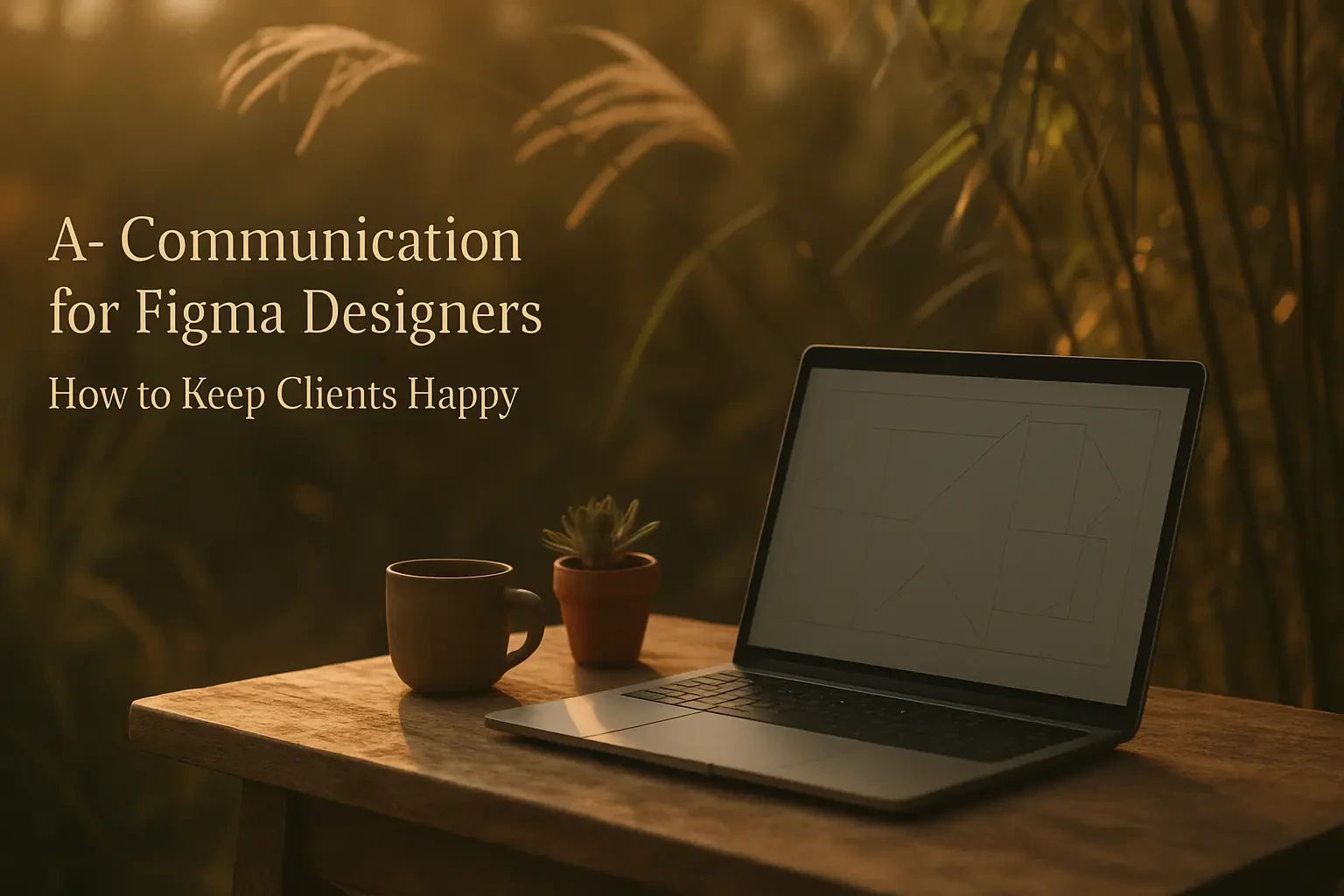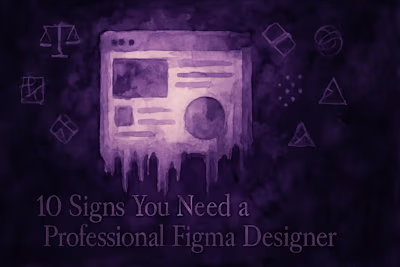A+ Communication for Figma Designers: How to Keep Clients Happy

A+ Communication for Figma Designers: How to Keep Clients Happy
Establishing Communication Ground Rules
Defining Communication Channels and Frequency
Setting Office Hours and Response Times
Proactive Updates and Progress Reporting
The Art of the Weekly Status Update
Using Visuals to Communicate Progress
Communicating Delays and Challenges
Mastering Active Listening and Feedback
The Power of Active Listening
Encouraging and Structuring Client Feedback
Conclusion
References
A+ Communication for Figma Designers: How to Keep Clients Happy
Great design speaks for itself, but great designers? They know how to speak to their clients. If you've been freelancing as a Figma designer for any length of time, you've probably noticed that your communication skills matter just as much as your design chops. Maybe even more.
Here's the thing: clients don't just hire you for pretty mockups. They're investing in someone who can translate their vision into reality while keeping them in the loop every step of the way. That's where exceptional communication comes in. It's your secret weapon for building trust, dodging those dreaded miscommunication disasters, and keeping clients so happy they'll come back for more. The journey starts with a smooth client onboarding process that sets the right tone from day one. After that, it's all about maintaining momentum with regular updates and managing feedback and revisions like a pro. And if you're on the other side looking to work with designers who've mastered this art, you can hire top Figma designers who know how to keep the conversation flowing.
Establishing Communication Ground Rules
Let's be real: nothing kills a project faster than mismatched expectations about communication. You know the scenario. The client expects daily updates while you're planning to check in weekly. They're messaging you at midnight expecting instant responses while you're trying to maintain some semblance of work-life balance. Sound familiar?
Setting up communication ground rules isn't about being rigid or difficult. It's about creating a framework that works for everyone involved. Think of it as designing the user experience of your client relationship. Just like you wouldn't start designing without understanding user needs, you shouldn't dive into a project without establishing how you'll communicate.
Defining Communication Channels and Frequency
First things first: where and how often will you talk? This might seem basic, but you'd be surprised how many projects go sideways because nobody clarified this upfront.
Start by having an honest conversation about communication preferences. Some clients live in their email inbox. Others prefer the quick back-and-forth of Slack. Video calls might be essential for complex discussions, while simple updates could work fine as Loom recordings. The key is finding what works for both of you.
Here's a practical approach: suggest a communication stack that covers different needs. Maybe email for formal approvals and important decisions. Slack or similar tools for quick questions and daily collaboration. Weekly video calls for deeper discussions and relationship building. Whatever you choose, document it clearly in your project agreement.
Frequency matters too. Some clients need more hand-holding than others, and that's okay. But you need to set realistic expectations. A daily check-in might work for a two-week sprint, but it's probably overkill for a three-month project. Weekly updates often hit the sweet spot for most projects. They're frequent enough to maintain momentum but not so constant that they become a burden.
Setting Office Hours and Response Times
This one's crucial for your sanity. Just because you're a freelancer doesn't mean you're available 24/7. In fact, setting clear boundaries often makes clients respect you more, not less.
Be upfront about when you're available for real-time communication. Maybe you're online from 9 AM to 5 PM in your timezone. Perhaps you batch client calls on certain days. Whatever your schedule, communicate it clearly and stick to it.
Response times are equally important. Set expectations for how quickly clients can expect replies. For example: "I respond to emails within 24 hours on business days" or "Slack messages during office hours get responses within 2 hours." This prevents the anxiety of clients wondering if you got their message and gives you breathing room to focus on actual work.
Pro tip: Include these details in your email signature and Slack status. It's a gentle reminder that keeps expectations in check without having to repeat yourself constantly.
Proactive Updates and Progress Reporting
Want to know the fastest way to make a client nervous? Go radio silent for a week. Even if you're heads-down creating amazing work, silence breeds anxiety. Clients start wondering if you've forgotten about them, if the project's on track, or if you've been abducted by aliens.
Proactive communication flips the script. Instead of clients chasing you for updates, you're keeping them informed before they even think to ask. This builds massive trust and positions you as a reliable professional who's got everything under control.
The Art of the Weekly Status Update
The weekly status update is your communication workhorse. Done right, it keeps clients informed, prevents scope creep, and creates a paper trail of project progress. Done wrong, it's just another email nobody reads.
Keep your updates scannable and action-oriented. Start with a quick summary of what you accomplished this week. Use bullet points liberally. Nobody wants to read a novel about your design process. They want to know: What got done? What's coming next? Are there any roadblocks?
Here's a template that works:
This Week's Progress:
Completed homepage wireframes
Refined color palette based on feedback
Created three variations of the navigation menu
Next Week's Focus:
Design mobile responsive versions
Create interactive prototype for user testing
Prepare presentation for stakeholder review
Questions/Blockers:
Need final copy for the About page by Wednesday
Awaiting approval on logo placement
See how clean that is? Your client can scan it in 30 seconds and know exactly where things stand.
Using Visuals to Communicate Progress
You're a visual designer. Use that superpower in your communication! A screenshot or quick screen recording often communicates progress better than paragraphs of text.
Figma makes this ridiculously easy. Share view-only links to your work-in-progress files. Use Figma's commenting feature to highlight specific areas you want feedback on. Create simple prototypes to show interactions and user flows. These visual updates make abstract progress tangible.
Consider creating a dedicated "Client Review" page in your Figma file. Update it weekly with the latest designs, making it easy for clients to see evolution over time. Add notes explaining your design decisions. This transparency builds trust and helps clients feel involved without micromanaging.
Quick video walkthroughs work wonders too. A 2-3 minute Loom video where you explain your latest work adds a personal touch and often prevents misunderstandings that can happen with written communication alone.
Communicating Delays and Challenges
Nobody likes delivering bad news, but delays and challenges are part of every project. The difference between good and great designers? How they handle these situations.
First rule: communicate issues as soon as you spot them. Don't wait until the deadline to mention you're running behind. The earlier you flag potential problems, the more options everyone has to address them.
Second rule: always come with solutions. "The project will be delayed" is bad communication. "The additional revisions mean we'll need an extra three days, but I can deliver the homepage by Friday as planned if we push the subpages to next week" is professional problem-solving.
Be honest about the cause without making excuses. If you underestimated the work, own it. If the client's feedback requires significant rework, explain the impact clearly. Transparency builds trust even in difficult situations.
Remember to document these conversations. Follow up verbal discussions with written summaries. This protects both you and the client and ensures everyone's on the same page about adjusted timelines or scope.
Mastering Active Listening and Feedback
Here's something they don't teach in design school: half of great communication is shutting up and listening. Really listening. Not just waiting for your turn to talk or mentally preparing your defense of that color choice they're questioning.
Active listening transforms your client relationships. It helps you understand not just what clients are saying, but what they actually need. Sometimes a client says "make it pop more" when they really mean "help me stand out from my competitors." Your job is to dig deeper and uncover those real needs.
The Power of Active Listening
Active listening starts with giving your full attention. Close those other browser tabs during client calls. Take notes. Ask clarifying questions. Show that you're engaged and processing what they're saying.
One powerful technique: reflect back what you're hearing. "So if I understand correctly, you're concerned that the current design might not appeal to your younger demographic?" This does two things. It confirms you understood correctly and gives clients a chance to clarify if needed.
Don't rush to solutions. When a client shares a concern, resist the urge to immediately defend your work or propose fixes. First, make sure you fully understand the issue. Ask questions like "Can you help me understand what's not working for you?" or "What would success look like here?"
Body language matters too, even on video calls. Maintain eye contact through the camera. Nod to show understanding. These small cues signal that you're present and engaged.
Encouraging and Structuring Client Feedback
Getting good feedback is an art form. Left to their own devices, clients might give you vague comments like "it doesn't feel right" or "my spouse doesn't like it." Your job is to guide them toward specific, actionable feedback.
Start by setting the stage. Before showing work, explain what stage you're at and what kind of feedback would be most helpful. "Today I'm showing you initial concepts, so I'm looking for feedback on the overall direction rather than specific details like font choices."
Ask specific questions to guide their thinking:
"How well does this align with your brand values?"
"Which elements best communicate your message?"
"What concerns do you have about how your users might interact with this?"
Create a feedback framework. Maybe you use a simple format: What's working? What's not working? What questions do you have? This structure helps clients organize their thoughts and ensures you get balanced input.
Teach clients how to give better feedback. When they say something vague, dig deeper. "It needs more energy" becomes "Are you looking for brighter colors, more dynamic imagery, or bolder typography?" Over time, clients learn to be more specific from the start.
Document all feedback meticulously. After feedback sessions, send a summary of what you heard and your planned next steps. This prevents the dreaded "but I thought we agreed on X" conversations later.
Conclusion
Exceptional communication isn't just a nice-to-have skill for Figma designers. It's the difference between constantly chasing clients and having them chase you. It's what transforms one-off projects into long-term partnerships. Most importantly, it's what makes freelancing enjoyable instead of stressful.
The strategies we've covered aren't complicated. Set clear communication expectations upfront. Keep clients informed with regular, visual updates. Handle challenges with transparency and solutions. Listen actively and guide clients to give better feedback. Simple concepts, but powerful when applied consistently.
Start small. Pick one area to improve this week. Maybe it's setting up a weekly update template or defining your office hours. As these practices become habits, layer in more. Before long, you'll notice projects running smoother, clients trusting you more, and your stress levels dropping significantly.
Remember, great communication is a skill you develop over time. Every client interaction is a chance to refine your approach. Pay attention to what works and what doesn't. Adjust your methods based on different client personalities and project types.
The best part? When you nail client communication, everything else gets easier. Clear communication prevents scope creep, reduces revisions, and builds the kind of trust that leads to referrals and repeat business. It's an investment that pays dividends throughout your entire freelance career.
So go ahead, put these strategies into practice. Your future self (and your clients) will thank you.
References
Like this project
Posted Jul 6, 2025
Great design isn't enough. Learn essential client communication strategies for Figma designers to keep projects on track, build trust, and ensure client happiness.









